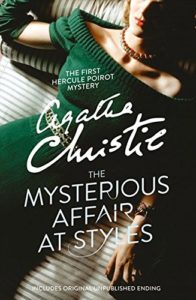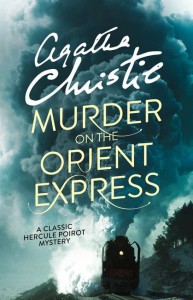Books
Getting over heartbreak, Agatha Christie style
In 1926, the Queen of Crime went missing, turning up 11 days later. In What Would Boudicca Do?, E. Foley and B. Coates explore the mysterious affair of Agatha Christie’s disappearance.
Literary powerhouse Dame Agatha Christie is the bestselling fiction writer of all time. Her crime novels, including those featuring her busybody detectives Hercule Poirot and Miss Marple, are famous the world over, and have been translated into more than one hundred languages. She is also the author of the hit play The Mousetrap, which has been running continuously in London’s West End since 1952. Alongside this she wrote romance novels, won several awards and a DBE, and her books have been adapted for TV and film. However, success in work doesn’t necessarily mean success in life. In fact, women who outshine their husbands often suffer for it. Agatha certainly did.
 Agatha Mary Clarissa Miller was born in Torquay into an affluent household. As a child, she loved reading, as most blossoming authors do, and started writing stories in her teens. After her father died in 1901, Agatha and her mum became a tight-knit unit, living and travelling together. In 1912 she met the dashing pilot Archibald Christie, whom she married in 1914 but did not properly live with until after the end of World War I when he returned from service in France in 1918. During the war Agatha worked as a pharmacist in a hospital in Torquay. This experience, especially what she learned about poisons, would prove very useful in her later career. In her spare time she started writing her first detective novel, featuring the marvellously moustachioed Poirot, The Mysterious Affair at Styles. In 1919, she and Archie moved into their first flat in London and had their only child, Rosalind. The next year Styles was published and Agatha’s life changed overnight.
Agatha Mary Clarissa Miller was born in Torquay into an affluent household. As a child, she loved reading, as most blossoming authors do, and started writing stories in her teens. After her father died in 1901, Agatha and her mum became a tight-knit unit, living and travelling together. In 1912 she met the dashing pilot Archibald Christie, whom she married in 1914 but did not properly live with until after the end of World War I when he returned from service in France in 1918. During the war Agatha worked as a pharmacist in a hospital in Torquay. This experience, especially what she learned about poisons, would prove very useful in her later career. In her spare time she started writing her first detective novel, featuring the marvellously moustachioed Poirot, The Mysterious Affair at Styles. In 1919, she and Archie moved into their first flat in London and had their only child, Rosalind. The next year Styles was published and Agatha’s life changed overnight.
Suddenly, dear Agatha was all the rage. She published a novel almost every year, and sometimes more, until 1976. The spondulicks rolled in and in 1925 the Christies bought a house in Berkshire which they called Styles after the book which paid for it. However, Archie was not terribly interested in his wife’s métier, preferring to spend his time playing golf. The next year Agatha was poleaxed by the death of her beloved mother, and again Archie’s response was to hit the links rather than dispense the hugs. In fact, he had begun an affair with a young secretary who liked golf more than Agatha, Nancy Neele, and one night in December he told Agatha he wanted a divorce.
What happened next, and why, has been the subject of conjecture ever since: a mystery that even Miss Marple would struggle with. Once Archie had swanned off to his girlfriend’s house, Agatha kissed her daughter goodnight (leaving her in the care of the servants) and drove off. Her car was found the next day but Agatha was not. A huge media frenzy ensued, with speculation abounding that Archie had murdered his wife, or that she was trying to frame him for her murder Gone Girl-style, or that it was a publicity stunt to push sales of her most recent book.
Agatha’s disappearance was front-page news internationally and hundreds of police officers were involved in the investigation. Arthur Conan Doyle even took one of her gloves to a psychic for help (thanks, Arthur). Eleven days later Agatha was discovered in what is now the Old Swan Hotel in Harrogate (which today holds an annual festival for fans of crime fiction in her honour). In a nod to her rival, she had checked in as Teresa Neele from South Africa and had had a lively old time, singing and playing the piano in the bar – quite unlike her usual shy, brownish, somewhat dowdy self. She didn’t initially recognise Archie when he came to collect her and doctors diagnosed her with an amnesiac breakdown, which others have speculated was possibly caused by a concussion from crashing her car on the way to commit suicide. She recovered and she and Archie were finally divorced in 1928; he promptly married Nancy. Agatha treated herself to a trip on the Orient Express as her heartbreak holiday (see Murder on the Orient Express for the somewhat backhanded advertising she later gave this jaunt).
 Agatha’s star continued in its ascendancy, and she kept up her travels. On one excursion she met the archaeologist Max Mallowan, whom she married in 1930, moving on to a more settled life. During World War II she volunteered again in a hospital, and also wrote some of her best work. In 1956 she was awarded a CBE (and later made a dame) and the next year became President of the Detection Club, a society of crime writers where members pledged allegiance with this fabulous oath: ‘Do you promise that your detectives shall well and truly detect the crimes presented to them, using those wits which it may please you to bestow on them, and not placing reliance on nor making use of Divine Revelation, Feminine Intuition, Mumbo-Jumbo, Jiggery-Pokery, Coincidence or Act of God.’ In 1976 she died peacefully at home in Oxfordshire, leaving behind an unmatched literary legacy.
Agatha’s star continued in its ascendancy, and she kept up her travels. On one excursion she met the archaeologist Max Mallowan, whom she married in 1930, moving on to a more settled life. During World War II she volunteered again in a hospital, and also wrote some of her best work. In 1956 she was awarded a CBE (and later made a dame) and the next year became President of the Detection Club, a society of crime writers where members pledged allegiance with this fabulous oath: ‘Do you promise that your detectives shall well and truly detect the crimes presented to them, using those wits which it may please you to bestow on them, and not placing reliance on nor making use of Divine Revelation, Feminine Intuition, Mumbo-Jumbo, Jiggery-Pokery, Coincidence or Act of God.’ In 1976 she died peacefully at home in Oxfordshire, leaving behind an unmatched literary legacy.
Agatha’s books are often regarded as rather cosy, polite stories of murder, but are much more vicious and dark than this interpretation suggests. Her tweedy image is also undercut by the melodrama of her famous vanishing act on being ditched by her man. We can all learn a lesson from her behaviour in the aftermath. She made damn sure that her husband’s infidelity was not going to go unnoticed, and he wasn’t able to skip off to his bit-on-the-side for Netflix and chill without some severe public awkwardness. Although we don’t endorse setting up your ex as a murderer, we do think that being dumped deserves a bit of drama and wallowing, and certainly a nice holiday to help you get over it. Who knows who you might meet on your travels? And, as a final aside about how Agatha was so much cooler than you might imagine, in the 1920s she became the first British woman to surf standing up, while travelling in South Africa. So golf can go fuck itself.
What Would Boudicca Do?: Everyday Problems Solved by History’s Most Remarkable Women by E. Foley and B. Coates, illustrated by Bijou Karman, is published by Faber & Faber in September (£9.99)



Please note: Moderation is enabled and may delay your comment being posted. There is no need to resubmit your comment. By posting a comment you are agreeing to the website Terms of Use.